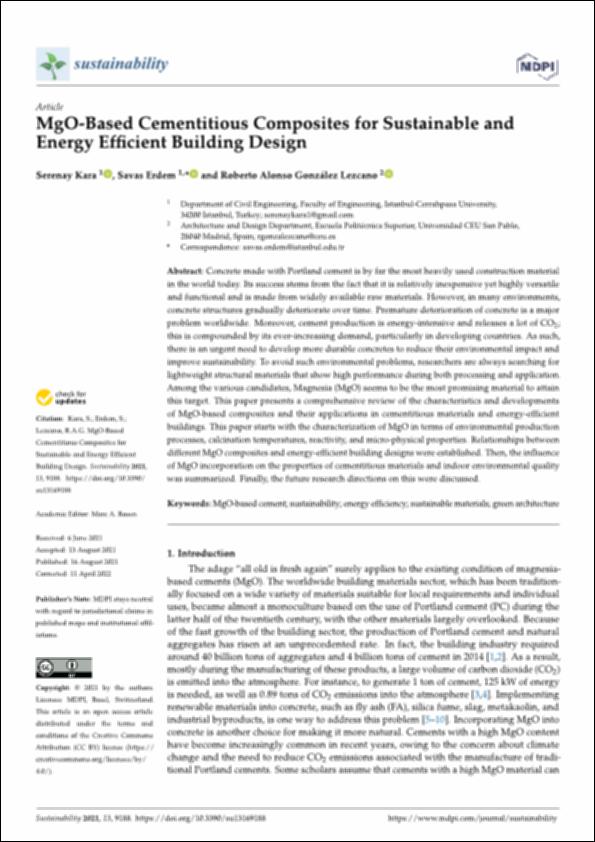Please use this identifier to cite or link to this item:
http://hdl.handle.net/10637/14585MgO-Based Cementitious Composites for Sustainable and Energy Efficient Building Design

See/Open:
MgO_Kara_et_al_Sustainability_2022.pdf
2,72 MB
Adobe PDF
See/Open:
Correccion_MgO_Kara_et_al_Sustainability_2022.pdf
179,56 kB
Adobe PDF
| Title: | MgO-Based Cementitious Composites for Sustainable and Energy Efficient Building Design |
| Authors : | Kara, Serenay. Erdem, Savas González Lezcano, Roberto Alonso. |
| Keywords: | Sustainability; Energy efficiency; Green architecture |
| Publisher: | MDPI |
| Citation: | Kara, S.; Erdem, S.; Lezcano, R.A.G. MgO-Based Cementitious Composites for Sustainable and Energy Efficient Building Design. Sustainability 2021, 13, 9188. https://doi.org/10.3390/ su13169188 |
| Abstract: | Concrete made with Portland cement is by far the most heavily used construction material in the world today. Its success stems from the fact that it is relatively inexpensive yet highly versatile and functional and is made from widely available raw materials. However, in many environments, concrete structures gradually deteriorate over time. Premature deterioration of concrete is a major problem worldwide. Moreover, cement production is energy-intensive and releases a lot of CO2; this is compounded by its ever-increasing demand, particularly in developing countries. As such, there is an urgent need to develop more durable concretes to reduce their environmental impact and improve sustainability. To avoid such environmental problems, researchers are always searching for lightweight structural materials that show high performance during both processing and application. Among the various candidates, Magnesia (MgO) seems to be the most promising material to attain this target. This paper presents a comprehensive review of the characteristics and developments of MgO-based composites and their applications in cementitious materials and energy-efficient buildings. This paper starts with the characterization of MgO in terms of environmental production processes, calcination temperatures, reactivity, and micro-physical properties. Relationships between different MgO composites and energy-efficient building designs were established. Then, the influence of MgO incorporation on the properties of cementitious materials and indoor environmental quality was summarized. Finally, the future research directions on this were discussed. |
| Description: | Se incluye corrección realizada por los autores en la misma revista v.14, 4528 (2022) |
| URI: | http://hdl.handle.net/10637/14585 |
| Rights : | http://creativecommons.org/licenses/by-nc-nd/4.0/deed.es OpenAccess |
| ISSN: | 2071-1050 |
| Issue Date: | 11-Apr-2022 |
| Center : | Universidad San Pablo-CEU |
| Appears in Collections: | Escuela de Politécnica Superior |
Items in DSpace are protected by copyright, with all rights reserved, unless otherwise indicated.

